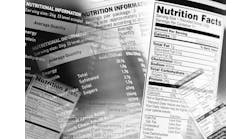Every five years, the Dept. of Health and Human Services (HHS) and USDA jointly issue the latest iteration of the federal government's guidance on healthy eating, the Dietary Guidelines. The guidelines not only inform as to how government feeds its millions of employees (including the military) and those who eat in a government facility (i.e. public schools, prisons), but they also influence food-related laws and regulations.
A federal advisory committee in February issued its recommended updates to the guidelines. If the agencies embrace the committee’s recommendations, the 2015 “My Plate” will feature supersized, empty-calorie portions of activism and food-nanny nagging. We will be lectured on the need to eat “sustainably,” watch labels for "added sugars” and the need for marketing restrictions on certain foods.
None of the recommendations should come as a surprise, given the makeup of the Dietary Guidelines Advisory Committee (DGAC) and the motivations of the regulators at HHS and USDA who appointed its 15 members. Every single member is from academia. As one assessment, published by Capital Research Center, noted, “There is not a single business owner, family physician, working nutritionist, food services executive, or federal nutrition program director in the mix.” That assessment wisely added that such homogeneity enhanced the likelihood of “groupthink.”
Some committee members have openly advocated for government intervention in our dietary choices, while others have exhibited hostility toward particular foods, such as beef. Vice Chair Alice Lichtenstein, a Tufts University professor, has championed policies aimed at shifting consumer demand, including an ideologically tinged speech where she took a macabre shot at Ronald McDonald. DGAC member Frank Hu of Harvard University, on the basis of an observational study he co-authored, has publicly urged Americans to abandon even moderate consumption of red meat in favor of a plant-based diet.
The “plant-based diet” that Dr. Hu advocates figures prominently in the DGAC’s recommendations. They suggest a diet “rich in vegetables, fruits, whole grains ...” and “lower in red and processed meat.” But is the committee's recommendation based solely on the latest nutritional science, or is it motivated by something other than dietary health?
| [javascriptSnippet ] |
That question must be asked given the work of the DGAC subcommittee, “Food Sustainability and Safety.” That subcommittee studied the “proportional environmental impacts (greenhouse gas emissions, water pollution) of current growing and processing practices for the overall food system,” which included a focus on meat.
The subcommittee included Dr. Hu, and its work was informed by two consultants, Tufts University’s Timothy Griffin and Michigan State’s Michael Hamm, both of whom are experts in agricultural sustainability but have no expertise on human nutrition. The DGAC heard testimony in January 2014 from Dr. Kate Clancy of the Center for a Livable Future at Johns Hopkins University's Bloomberg School of Public Health. Dr. Clancy singled out beef as the “greatest concern” with regard to “biodiversity, land use, greenhouse gas emissions,” among other factors. She favorably cited to “European precedents” for environmentally healthy food, such as Sweden’s 2009 Environmentally-smart Food Choices” guidelines and 2011 guidelines from the Netherlands, Guidelines for a Healthy Diet: The Ecological Perspective (the guidelines open in a PDF).
The DCAG report baldly states, “A diet higher in plant-based foods ... and lower in animal-based foods, is more health promoting and is associated with less environmental impact than is the current U.S. diet.” The use of “associated with,” which falls well short of a causal relationship, is quite revealing. The report also calls for extensive research on the relationship between “sustainable” foods and Americans' health (which, not coincidentally, would create a source of sustainable government research funding for academics of the DGAC members’ ilk).
All that exists at this point, as Dr. C. Alan Rotz of Penn State University noted in a comment to the DGAC, is “a growing amount of pseudo science coming available that is primarily developed to condemn certain products and lifestyles.” When assessing whether to follow the DGAC’s lead on sustainability in the final Dietary Guidelines, the secretaries of HHS and USDA would be wise to recall the warning (the warning opens in a PDF) the House of Representatives issued as a Congressional Directive in the 2015 Omnibus Appropriations Legislation.
DGAC’s report also mirrors public health activists’ claims against “added sugars.” It doesn't, of course, bother to explain that sugars that are “added” bear no physiological difference from sugars that are intrinsic in food. The language suggested by the DGAC’s “Added Sugars Working Group,” and adopted by the full committee, includes support for the FDA effort to list “added sugars” under “total sugars” on the Nutrition Facts label. Comments, which can be found in this PDF, filed with FDA by the Washington Legal Foundation say the need for such a distinct “added sugars” line lacks any statutory or scientific basis, is more likely to mislead consumers than positively inform them, and is constitutionally suspect under the First Amendment.
The report also includes support for “economic and pricing approaches, using incentives and disincentives” for the reduction of added sugars (similar to the soda tax Berkeley, Calif., will be implementing this year), and calls for “policies that limit exposure and marketing of foods and beverages considered high in added sugars to young children, youth and adolescents.” Such recommendations certainly are in line with the types of policies DGAC Vice Chair Lichtenstein has advocated in the past, but they have no place in the federal government's official
Dietary Guidelines.The public can comment on the DGAC report until May 8. Comments can be submitted at www.DietaryGuidelines.gov. We trust that the agencies will then take such comments more seriously than DGAC took those it received last year. Most likely, Congress will also weigh in.
The federal government’s Dietary Guidelines always fall short of providing clear, consistent recommendations for healthy eating. But 2015 may mark the year that the guidelines go from being an easily dismissed distraction to a damaging vehicle that's eating away at Americans' freedom of choice.
